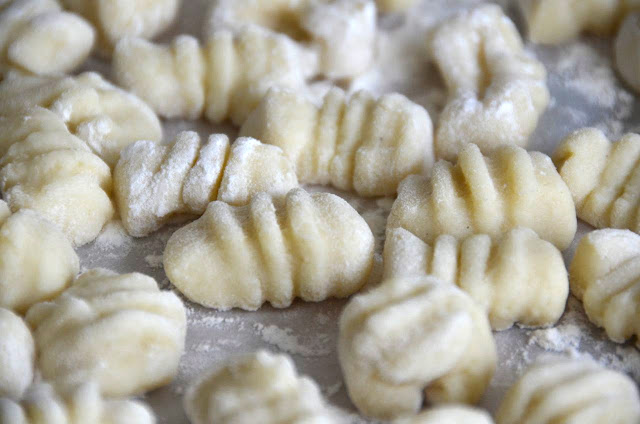

One word: IRRESISTIBLE! They were meant to be a one-off, but surely did not stay that way. This must be the fourth time I have made them, and I can't see myself purchasing their plastic-wrapped, now clearly in the deepest shadow, Supermarket cousins anytime soon. Yes, they may be time-consuming and quite a bit of an effort, and the shaping requires a little practice, but it's not all that difficult, even for my unskilled non-Italian hands. One batch offers plenty of practice, and in the end the quality makes really up for it. Also, freshly made and frozen they turn into a perfect quick mid-week evening meal, especially as they can be cooked straight from frozen, needing just a couple of more minutes cooking time. A great companion for home-made PESTO ALLA GENOVESE, a simple Tomato Sauce, or my favourite: SAUSAGE AND PORCINI SAUCE.
Ingredients based on: Giancarlo Caldesi: How to Make Gnocchi
(Signor Caldesi does not show how to shape his Gnocchi into the traditional form unfortunately, so more of that below. I also replaced the pepper with nutmeg)
1kg starchy potatoes (I read that red starchy ones are best as they hold the potato better in the skin during boiling and are more tasty, but I used normal white starchy ones for this recipe. Just make sure not to overcook them until their skin bursts)
300g '00' flour + additional for dusting
1 large egg
1 tsp salt
freshly grated nutmeg
additional salt for boiling
Boil the potatoes:
Wash the potatoes, then place them unpeeled in a large pot and cover with cold water - it is important to use cold water as the potato skins may split if they are put immediately into boiling water. Bring to the boil, then reduce the heat and cook the potatoes gently until they are soft and can be easily pierced with a skewer or knife. The potatoes should fall off the skewer after piercing, if they hold on, more cooking is needed. Drain the potatoes, then, holding the potatoes with a kitchen towel to protect the hand from burning, peel the skins off with a small knife while still hot. Make the dough immediately following the steps below.
Make the dough:

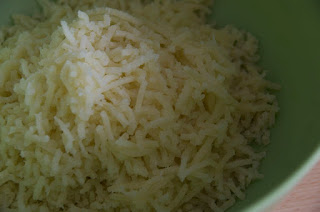
Leave the riced potatoes to cool just a little, then add the egg and stir in quickly in order for the egg not to start cooking from the heat of the potatoes. Season with the salt and some freshly grated nutmeg and stir. Add some of the flour and start to stir gently into a dough-like texture, then put the mixture onto a work surface.




Add the remaining flour, little at a time, and knead very gently into a soft, smooth dough. Try not to overknead and handle too much as the dough will become more sticky and require even more flour. If the flour sticks to the work surface, use a dough scraper to scrape off the sticky bits and knead them back into the potatoes. The final flour amount depends on the type of potatoes used, the size of egg, etc. The dough should be smooth and very soft.
Shape the Gnocchi:
Cut off a small piece of dough with a dough scraper or a knife. Dust the work surface, then roll the dough piece into a long rope, app. 2cm thick. Cut the rope into 2 cm pieces.

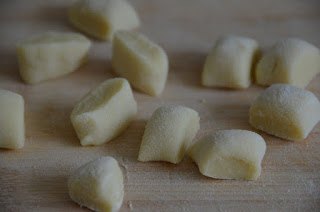

Gnocchi are often served just like this, but I prefer them with the proper pattern and shape as they soak up a lot more sauce. To do this, flour hands, then take each Gnocchi one-by-one, place into a little flour and roll into a small ball. Then roll over the tines of a fork to make the typical Gnocchi pattern and shape: to do so, hold the fork with one hand, tip of the tines leaning on the work surface, and concave side up, at a slight angel to the surface. Put the tip of your thumb into flour, then place one Gnocchi on the top of the tines. Roll the Gnocchi downwards with the tip of your thumb, applying little pressure.
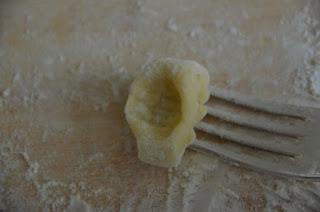

The Gnocchi will start to flatten a little underneath the thumb, but through the downward movement will also start to roll around the tip of the thumb in a circle-like motion into a C-shape. You want to end up with a small cavity inside the Gnocchi and the typical pattern created by the ridges on the other side. The picture shows it a bit extreme and the opening does not need to stay like this, normally the rolling movement closes the Gnocchi, or it can be pressed together a little at the end. I did shoot a couple of pictures to show this in more detail, but my thumb stuck inside the gnocchi was no real eye-candy ;-)
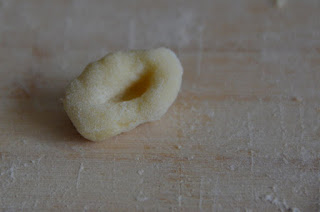

Put the Gnocchi onto a surface dusted with flour. Repeat with the remaining dough balls until all Gnocchi have been shaped. This does need a little practice, but there's plenty of that with 1kg of potatoes... and they don't need to be all perfect and identical, they still taste nice :-)
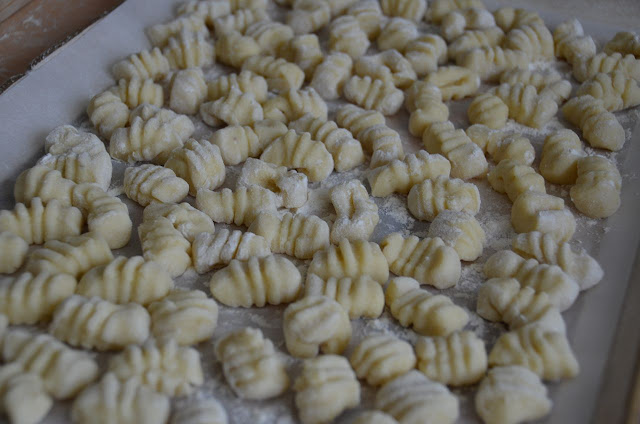
Make the dough:
Put the peeled potatoes through a potato ricer - this will incorporate air, making the potatoes even fluffier. It is important that these initial steps are done very quickly, as the hotter the potatoes, the softer the Gnocchi will be.


Leave the riced potatoes to cool just a little, then add the egg and stir in quickly in order for the egg not to start cooking from the heat of the potatoes. Season with the salt and some freshly grated nutmeg and stir. Add some of the flour and start to stir gently into a dough-like texture, then put the mixture onto a work surface.




Add the remaining flour, little at a time, and knead very gently into a soft, smooth dough. Try not to overknead and handle too much as the dough will become more sticky and require even more flour. If the flour sticks to the work surface, use a dough scraper to scrape off the sticky bits and knead them back into the potatoes. The final flour amount depends on the type of potatoes used, the size of egg, etc. The dough should be smooth and very soft.
Shape the Gnocchi:
Cut off a small piece of dough with a dough scraper or a knife. Dust the work surface, then roll the dough piece into a long rope, app. 2cm thick. Cut the rope into 2 cm pieces.



Gnocchi are often served just like this, but I prefer them with the proper pattern and shape as they soak up a lot more sauce. To do this, flour hands, then take each Gnocchi one-by-one, place into a little flour and roll into a small ball. Then roll over the tines of a fork to make the typical Gnocchi pattern and shape: to do so, hold the fork with one hand, tip of the tines leaning on the work surface, and concave side up, at a slight angel to the surface. Put the tip of your thumb into flour, then place one Gnocchi on the top of the tines. Roll the Gnocchi downwards with the tip of your thumb, applying little pressure.


The Gnocchi will start to flatten a little underneath the thumb, but through the downward movement will also start to roll around the tip of the thumb in a circle-like motion into a C-shape. You want to end up with a small cavity inside the Gnocchi and the typical pattern created by the ridges on the other side. The picture shows it a bit extreme and the opening does not need to stay like this, normally the rolling movement closes the Gnocchi, or it can be pressed together a little at the end. I did shoot a couple of pictures to show this in more detail, but my thumb stuck inside the gnocchi was no real eye-candy ;-)


Put the Gnocchi onto a surface dusted with flour. Repeat with the remaining dough balls until all Gnocchi have been shaped. This does need a little practice, but there's plenty of that with 1kg of potatoes... and they don't need to be all perfect and identical, they still taste nice :-)

Cook:
Bring plenty of water to a boil, salt and put the Gnocchi inside, small portions at a time and shaking off access flour as much as possible. Reduce the heat a bit and leave to cook gently. When the Gnocchi are cooked - and this will take no more than a couple of minutes - they will rise to the surface. Spoon off with a slotted spoon and put into the prepared sauce. Stir well with the sauce and serve, sprinkled with a little freshly grated Parmesan.
In case the Gnocchi need to be frozen, place the freshly made Gnocchi in a single layer onto a tray that fits inside the freezer. Freeze until hard for a couple of hours - this will prevent them from sticking together later. Once hard, place the frozen Gnocchi into a freezer bag and freeze until use. They should keep for several weeks. Gnocchi can be boiled immediately from frozen, they will just take a couple of minutes longer to cook.

______________________________________________________
HOME-MADE POTATO GNOCCHI



1kg starchy potatoes (I read that red starchy ones are best as they hold the potato better in the skin during boiling and are more tasty, but I used normal white starchy ones for this recipe. Just make sure not to overcook them until their skin bursts)
300g '00' flour + additional for dusting
1 large egg
1 tsp salt
freshly grated nutmeg
additional salt for boiling
1) Boil and peel the potatoes: Wash the potatoes, then place them unpeeled in a large pot and cover with cold water - it is important to use cold water as the potato skins may split if they are put immediately into boiling water. Bring to the boil, then reduce the heat and cook the potatoes gently until they are soft and can be easily pierced with a skewer or knife. The potatoes should fall off the skewer after piercing, if they hold on, more cooking is needed. Drain the potatoes, then, holding the potatoes with a kitchen towel to protect the hand from burning, peel the skins off with a small knife while still hot. Make the dough immediately following the steps below.
2) Press the potatoes through a ricer: Put the peeled potatoes through a potato ricer - this will incorporate air, making the potatoes even fluffier. It is important that these initial steps are done very quickly, as the hotter the potatoes, the softer the Gnocchi will be.
3) Make the dough: Leave the riced potatoes to cool just a little, then add the egg and stir in quickly in order for the egg not to start cooking from the heat of the potatoes. Season with the salt and some freshly grated nutmeg and stir. Add some of the flour and start to stir gently into a dough-like texture, then put the mixture onto a work surface.
Add the remaining flour, little at a time, and knead very gently into a soft, smooth dough. Try not to overknead and handle too much as the dough will become more sticky and require even more flour. If the flour sticks to the work surface, use a dough scraper to scrape off the sticky bits and knead them back into the potatoes. The final flour amount depends on the type of potatoes used, the size of egg, etc. The dough should be smooth and very soft.
3) Shape the Gnocchi: Cut off a small piece of dough with a dough scraper or a knife. Dust the work surface, then roll the dough piece into a long rope, app. 2cm thick. Cut the rope into 2 cm pieces. Use the Gnocchi like this, or shape into traditional shape.
4) Shape Traditional Gnocchi: Flour your hands, then take each 2 cm piece from the step before one-by-one, place into a little flour and roll into a small ball. Roll it over the tines of a fork to make the typical Gnocchi pattern and shape: to do so, hold the fork with one hand, with the tines leaning on the work surface, and the forks concave side up, at a slight angel to the surface. Put the tip of your thumb into flour, then place one Gnocchi on a the top of the tines. Roll the Gnocchi downwards with the tip of your thumb, applying little pressure.
The Gnocchi will start to flatten underneath the thumb, but through the downward movement will also start to roll around the tip of the thumb in a circle-like motion into a C-shape. You want to end up with a small cavity inside the Gnocchi and the typical pattern created by the ridges on the other side. The rolling down movement closes the Gnocchi, or it can be pressed together a little at the end, leaving the small cavity inside. Put the Gnocchi onto a surface dusted with flour.
5) Finish with the remaining dough: Repeat with the remaining dough balls until all Gnocchi have been shaped. This does need a little practice, but there's plenty of that with 1kg of potatoes... and they don't need to be all perfect and identical, they still taste nice :-)
6) Cook the Gnocchi: Bring plenty of water to a boil, salt and put the Gnocchi inside, small portions at a time and shaking off access flour as much as possible. Reduce the heat a bit and leave to cook gently. When the Gnocchi are cooked - and this will take no more than a couple of minutes - they will rise to the surface. Spoon off with a slotted spoon and put into the prepared sauce. Stir well with the sauce and serve, sprinkled with a little freshly grated Parmesan.
Storing: In case the Gnocchi need to be frozen, place the freshly made Gnocchi in a single layer onto a tray that fits inside the freezer. Freeze until hard for a couple of hours - this will prevent them from sticking together later. Once hard, place the frozen Gnocchi into a freezer bag and freeze until use. They should keep for several weeks. Gnocchi can be boiled immediately from frozen, they will just take a couple of minutes longer to cook.

No comments:
Post a Comment